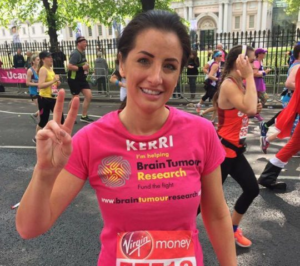 The ULTIMATE RED CARPET PERFORMANCE
The ULTIMATE RED CARPET PERFORMANCE
I love it when people who have been through hell walk out of the flames… ️
carrying buckets of water for those still consumed by fire. ️
A British Playboy Model Kerri Parker had a 13.5 percent chance of surviving from brain cancer. After undergoing major surgery to remove the 4-centimeter tumor that had grown in her frontal lobe, Parker is simply happy to be alive. However, she noticed that her surgery did leave one rather severe side effect: a complete personality change.
Kerri Parker told The Mirror that she had always been a vivacious extrovert. “I used to love being in the limelight,” Parker explained. The 34-year-old began modeling in 2003, and for nearly a decade enjoyed jetting from country – to – country to pose for numerous photo shoots. In 2012, she applied to be a Playmate and shortly after moved into the world-famous Playboy mansion.
“Then started attending red carpet events with Hugh and the girls every month and rubbed shoulders with Leonardo DiCaprio at star-studded parties” Parker said. Little did she know the dramatic change in the direction of her life would shortly take when doctors diagnosed the model with life-threatening brain cancer in 2013. Fortunately, the surgery went well and Parker made a swift recovery. However, it did not take long for the pretty brunette to notice that she still didn’t quite feel “herself” following the surgery.
“When I recovered from the operation I was a different person. At first, it was also small things,” explained Parker, describing oddities such as changes in food taste and no longer enjoying her favorite television programs. Soon it became apparent it was not just Parker’s taste in food and TV that changed. “I used to be the heart and soul of the party and now I’m a wallflower. I am a completely different person to who I used to be.”
Parker’s case is not isolated. Behavioral and personality changes following brain surgery are more common than one might believe. “Damage to specific areas of the brain, including the frontal & temporal lobes, amygdala, and the hippocampus might leave the survivor vulnerable to agitation, volatile emotions, memory impairment, verbal attacks, physical aggression, and impaired impulse control,” Psychology Today reported. Factors such as size, location, and type of brain tumor all play a role in the extent of personality changes an individual may experience.
Sarah Lindsell, chief executive of the Brain Tumor Charity, told The Mirror the reasoning behind brain cancer-induced personality changes. “The brain is such a complex organ that anything which disturbs its networks and pathways — by even a small amount – can have a significant effect. That means brain tumors and surgery to remove them can cause changes in personality.”
Despite the nearly complete personality change, Parker has continued to remain positive. “I don’t miss my old life. However, I do miss certain aspects, like having my independence. I have only just stopped living at home with my mum,” the former model explained. She is relearning how to live her life and above all has not forgotten that despite the losses caused by her surgery, what she gained in return is without a doubt greater. “Being so ill has made me realize what’s important in life. It’s not the glitz and glamour, but spending time with my family.”
September 2018, Kerri was informed that her earlier result of an ‘all clear’ was a mistake and she was now terminal with oligodendroglioma astrocytoma and mixed glioma. Kerri was advised that without chemotherapy and radiotherapy – that she would not survive to March of 2019. Kerri’s response to this dreadful news ?
She completed and achieved her Black Belt in a martial art!
 Presently Kerri is the fittest and healthiest
Presently Kerri is the fittest and healthiest
S0 when doctors tell her, “they want me to have treatment which will make me sick, it makes no sense to her.” ‘I don’t want my hair to fall out from chemo or my face burned from radiotherapy.’ Miss Parker, who runs the Kerri Parker Academy for model training in Norwich, is determined to seek alternative treatment not available in the U.K.
A former Playboy model — has refused chemotherapy to fight her brain cancer and says she will instead beat the disease using illegal cannabis oil. Kerri Parker had a tumor on her brain removed four years ago but was sadly told the cancer had returned by doctors in September. She has been told that her best hope of beating cancer is chemotherapy and radiotherapy but Kerri, a former lab technician, believes THC oil is ‘her only chance of living’.
The model and nutritionist, who has raised £20,000 for brain tumor research since her first diagnosis, has also went to a clinic in Mexico at the end of February, where she has spoken to people who say they have been cured of brain cancer through natural plants.
Kerri embark on her own treatment of vegan juices, Hoxsey herbs, Rick Simpson Oil, B17 tablet protocol and Fenbendazole ( panacur…a pet worming tablet). She continues to heal, she also feels better and her memory recall and intelligence are improved with no migraines… which until recently, plagued her daily. A higher THC to CBD oil was to be added later.
Miss Parker told her social media followers she will do “whatever it takes to find a natural cure for this disease” She wrote: “I will do whatever it takes to find a natural cure for this disease, use myself as a guinea pig to prove alternative treatments will work for her.
“So many people have reported to me that they lost their loved ones from cancer, due to radiotherapy and chemotherapy which kills a vast amount of patients. “I get so much grief for my choices people telling me I will die. But I know deep within me I will not, I am strong. I think my brutal outlook of refusing to accept I have cancer, refusal to accept a day off, rest, treatment – is why I have done so well.”
‘I can’t imagine any judge would convict a girl for using cannabis to save her life. It’s a risk I’m ready to take,’ she said. Cannabis is currently a category B drug in the UK which means possession can land someone with a sentence of up to five years in prison, unlimited fine or both. Dealing carries a sentence of up to 14 years in prison, an unlimited fine or both. Police can also issue a warning or an on-the-spot fine of £90 if someone is found with cannabis.
What is THC? Tetrahydrocannabinol, is one of at least 113 cannabinoids identified in cannabis. THC is the main psychoactive substance found in cannabis. Legal CBD oil is made up of a naturally occurring cannabinoid constituent of cannabis that contains only trace levels of THC – not enough to get a person high. The Home Office says that it can contain a maximum THC content of 0.2% and that the THC must not be easily separated from it but dose right. (Darren Miller with Green Angels had Life Saving Information.)
BEHOLD OLD MEDICINE – MODERN SCIENCE..takes just a minute to read…….First let’s look at what keeps cancer cells alive, and then we will come back and examine how the cannabinoids CBN (cannabinol) and THC (tetrahydrocannabinol) unravels cancer’s aliveness. In every cell there is a family of interconvertible sphingolipids that specifically manage the life and death of that cell. This profile of factors is called the “Sphingolipid Rheostat.” If endogenous ceramide (a signaling metabolite of sphingosine-1-phosphate) is high, then cell death (apoptosis) is imminent. If ceramide is low, the cell is strong in its vitality.
Very simply, when THC connects to the CB1 or CB2 cannabinoid receptor site on the cancer cell, it causes an increase in ceramide synthesis which drives cell death. A normal healthy cell does not produce ceramide in the presence of THC, thus is not affected by the cannabinoid.
The cancer cell dies, not because of cytotoxic chemicals, but because of a tiny little shift in the mitochondria. Within most cells there is a cell nucleus, numerous mitochondria (hundreds to thousands), and various other organelles in the cytoplasm. The purpose of the mitochondria is to produce energy (ATP) for cell use. As the ceramide starts to accumulate, turning up the Sphingolipid Rheostat, and it increases the mitochondrial membrane pore permeability to cytochrome c, a critical protein in energy synthesis. Cytochrome c is pushed out of the mitochondria, killing the source of energy for the cell.
Ceramide causes genotoxic stress in the cancer cell nucleus generating a protein called p53, whose job it is to disrupt calcium metabolism in the mitochondria. If this weren’t enough, ceramide disrupts the cellular lysosome, the cell’s digestive system provides nutrients for all cell functions. Ceramide, and other sphingolipids, actively inhibit pro-survival pathways in the cell leaving no possibility at all of cancer cell survival.
The key to this process is the accumulation of ceramide in the system. This means taking therapeutic amounts of CBN and THC, steadily, over a period of time, keeping metabolic pressure on this cancer cell death pathway.
How did this pathway come to be? Why is it that the body can take a simple plant enzyme and use it for profound healing in many different physiological systems? This endocannabinoid system exists in all animal life, just waiting for its matched exocannabinoid activator. This is interesting. Our own endocannabinoid system covers all cells and nerves; it is the messenger of information flowing between our immune system and the central nervous system (CNS). Its responsible for neuroprotection, and micro-manages the immune system. This is the primary control system that maintains homeostasis; our well-being.
Just out of curiosity, how does the work get done at the cellular level, and where does the body make the endocannabinoids? Here we see that endocannabinoids have their origin in nerve cells right at the synapse. When the body is compromised through illness or injury it calls insistently to the endocannabinoid system and directs the immune system to bring healing. If these homeostatic systems are weakened, it should be no surprise that exocannabinoids are therapeutic. It helps the body in the most natural way possible.
To see how this works we visualize the cannabinoid as a three dimensional molecule, where one part of the molecule is configured to fit the nerve or immune cell receptor site just like a key in a lock. There are at least two types of cannabinoid receptor sites, CB1 (CNS) and CB2 (immune). In general CB1 activates the CNS messaging system, and CB2 activates the immune system, but it’s much more complex than this. Both THC and anandamide activate both receptor sites. Other cannabinoids activate one or the other receptor sites. Among the strains of Cannabis, C. sativa tends toward the CB1 receptor, and C. indica tends toward CB2. So sativa is more neuroactive, and indica is more immunoactive. Another factor here is that sativa is dominated by THC cannabinoids, and indica is predominately CBN (cannabinol).
It is known that THC and CBN are biomimetic to anandamide, that is, the body can use both interchangeably. Thus, when stress, injury, or illnesses demand more from endogenous anandamide than can be produced by the body, therefore, its mimetic exocannabinoids are activated. If the stress is transitory, then the treatment can be transitory. If the demand is sustained, such as in cancer, then treatment needs to provide sustained pressure of the modulating agent on the homeostatic systems.
Typically CBN gravitates to the densely packed CB2 receptors in the spleen, home to the body’s immune system. From there, immune cells seek out and destroy cancer cells. Interestingly, it has been shown that THC and CBN cannabinoids have the ability to kill cancer cells directly without going through immune intermediaries. THC and CBN hijack the lipoxygenase pathway to directly inhibit tumor growth. As a side note, it has been discovered that CBN inhibits anandamide reuptake. Here we see that cannabinol helps the body preserve its own natural endocannabinoid by inhibiting the enzyme that breaks down anandamide.
This brief survey touches lightly on a few essential concepts. Mostly I would like to leave you with an appreciation that nature has designed the perfect medicine that fits exactly with our own immune system of receptors and signaling metabolites to provide rapid and complete immune response for systemic integrity and metabolic homeostasis.
Ps. Nowhere in this information does it mention CBD and here’s why; CBD does not bind directly to either of the CB1 or CB2 receptors unlocking the system but instead impacts them indirectly.
THC and CBN have a strong binding affinity for both CB1 and CB2 receptors, and cannabidiol (CBD) has no particular binding affinity. Instead, many of the therapeutic benefits of CBD are created through indirect actions. ~ AmyMiller
CBD oil can also be sold in the UK and is thought to have some medicinal properties, including relieving inflammation, pain relief and reducing anxiety. Kerri gets the THC she uses imported from Spain – where it is legal. ‘Not a single person said I’d made the wrong decision. My family are in support. Mum told me from day one she doesn’t want me having chemo,’ she said. ‘And Kerri fully believes we can beat cancer ourselves.’
https://www.youtube.com/watch?v=MFDll5hp-Wk
https://www.youtube.com/watch?time_continue=26&v=FpF_FPtrJ4c



